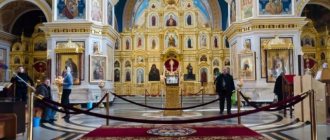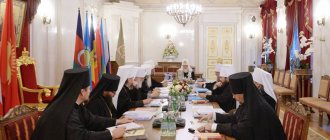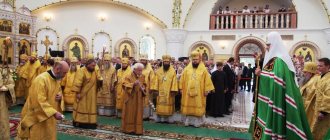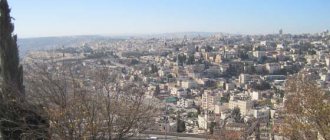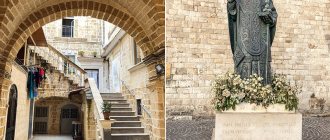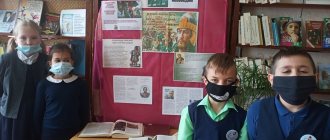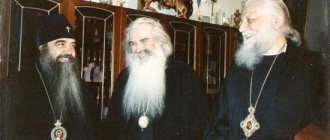| Michurinsk diocese Russian Orthodox Church | |
Bogolyubsky Cathedral | |
| basic information | |
| A country | Russia |
| Metropolis | Tambovskaya |
| Diocesan center | Michurinsk |
| Founded | December 26, 2012 |
| Cathedral Church | Bogolyubsky Cathedral (Michurinsk) |
| Second Cathedral | Trinity Cathedral (Morshansk) |
| Title of the ruling bishop | Michurinsky and Morshansky |
| Bishop | |
| Ruling bishop | Hermogenes (Gray) |
| With | from September 27, 2013 |
Michurinsk diocese
- diocese of the Russian Orthodox Church in the administrative boundaries of Michurinsky, Morshansky, Nikiforovsky, Pervomaisky, Petrovsky, Sosnovsky and Staroyurievsky districts of the Tambov region. It is part of the Tambov Metropolitanate[1].
Story
The vicariate of the Tambov diocese, named after the city of Kozlov, was established on December 10, 1868, but after the death of Bishop Ioannikiy (Moskvin) it was not replaced for a long time. Restored in 1904 by Bishop Innocent (Belyaev)[2].
After the city was renamed Michurinsk in 1932, the vicariate was named accordingly. Bishop Venedikt (Alentov), who took the Tambov see in 1936, was called Tambov and Michurinsky, which meant the abolition of the Michurin vicariate.
On December 26, 2012, by decision of the Holy Synod of the Russian Orthodox Church, the Michurinsk diocese was formed, which was separated from the Tambov diocese and included in the newly formed Tambov Metropolis[1].
In August 2013, the complex of buildings of the former St. Nicholas Orphanage and the Church in honor of St. Nicholas the Wonderworker, formerly known to city residents as the Lenin Club, was returned to the diocese. The diocesan administration will be located there[3].
Michurinsk and Morshansk diocese
Current analytics
The Primate of the Russian Church appealed to the Chairman of the Government of the Russian Federation with a request to support a bill limiting the use of assisted reproductive technologies for foreigners in Russia
On some issues of the position of the Ukrainian Orthodox Church in the context of international law and OSCE standards
Final document of the round table “Vaccination: ethical aspects in the light of Orthodox doctrine”
Archpriest Vladislav Tsypin: The Church court always hopes for the repentance of the guilty cleric
Address by His Holiness Patriarch Kirill on the occasion of International Day of Rare Diseases
Patriarchal address on the occasion of the celebration of Orthodox Youth Day
Speech by His Holiness Patriarch Kirill at a meeting of the Supreme Church Council on February 11, 2021
The Holy Synod stated the impossibility of Eucharistic communion with Archbishop Chrysostomos of Cyprus
How to help a person with alcohol addiction?
His Holiness Patriarch Kirill approved the decision to excommunicate Schemamonk Sergius (Romanov) from the Church
Report of the chairman of the Working Group on coordinating the activities of church institutions in the context of the spread of coronavirus infection at the meeting of the Holy Synod on August 25, 2021
Message of the Holy Synod of the Russian Orthodox Church to the episcopate, clergy, monastics and laity in connection with the harmful epidemic found this year
Statement of the Synodal Department for Relations of the Church with Society and the Media in connection with the threat of fraudulent actions against believers
Statement by Patriarch Kirill of Moscow and All Rus' in connection with the aggravation of the Armenian-Azerbaijani conflict
Statement of the Holy Synod of the Russian Orthodox Church in connection with the decision of the Turkish authorities to review the status of the Hagia Sophia Church
Statement by Patriarch Kirill of Moscow and All Rus' in connection with the events in Montenegro
Statement by Patriarch Kirill of Moscow and All Rus' in connection with the situation regarding Hagia Sophia
His Holiness Patriarch Kirill issued an order to reduce contributions to the Moscow Patriarchate
Message from His Holiness Patriarch Kirill on the 3rd Sunday after Easter, to the Holy Myrrh-Bearing Women
“After all, before, during epidemics, everyone went to church!” — Bishop virologist responds to outraged comments about coronavirus
Patriarchal message to the bishops, clergy, monastics and laity of the dioceses in Russia
Circular letter regarding His Holiness the Patriarch’s tour of the Mother See of the City with the Icon of the Mother of God “Tenderness”
Patriarchal sermon on the Sunday of the Worship of the Cross after the Liturgy in the Church of the Righteous Prince Igor of Chernigov in Peredelkino, Moscow
Instructions to rectors of parishes and farmsteads, abbots and abbesses of monasteries of the Moscow diocese in connection with the threat of the spread of coronavirus infection
Statement of the Holy Synod regarding the spread of coronavirus infection
Bishops
Kozlov Vicariate of Tambov Diocese
- Ioannikiy (Moskvin) (May 9 - October 25, 1869)
- Nathanael (Troitsky) (February 29, 1904 - October 31, 1908)
- Grigory (Yatskovsky) (November 21, 1908 - December 13, 1912)
- Zinovy (Drozdov) (January 17, 1913 - May 22, 1918)
- Pavel (Pospelov) (June 7, 1918 - 1921)
- Dimitry (Dobroserdov) (September 23, 1923 - early 1926)
- Alexy (Buy) (February 1926 - June 1927)
- Vassian (Pyatnitsky) (June 22, 1927 - April 9, 1930)
Michurinsk diocese
- Feodosius (Vasnev)
(December 26, 2012 - September 27, 2013) senior, Metropolitan. Tambovsky - Hermogenes (Gray) (since September 27, 2013)
History[ | ]
The vicariate of the Tambov diocese, named after the city of Kozlov, was established on December 10, 1868, but after the death of Bishop Ioannikiy (Moskvin) it was not replaced for a long time. Restored by Decree of the Holy Synod of February 5, 1904[2].
After the city was renamed Michurinsk in 1932, the vicariate was named accordingly. Bishop Venedikt (Alentov), who took the Tambov see in 1936, was called Tambov and Michurinsky, which meant the abolition of the Michurin vicariate.
On December 26, 2012, by decision of the Holy Synod of the Russian Orthodox Church, the Michurinsk diocese was formed, which was separated from the Tambov diocese and included in the newly formed Tambov Metropolis[1].
In August 2013, the complex of buildings of the former St. Nicholas Orphanage and the Church in honor of St. Nicholas the Wonderworker, formerly known to city residents as the Lenin Club, was returned to the diocese. The diocesan administration will be located there[3].
Links
other countries Argentine • Baku • Berlin • Brussels • Budapest • Vienna • Vilna • The Hague • Korsun • Sourozh Autonomous churches Chinese PC Beijing • Xinjiang • Tianjin • Harbin • Shanghai Japanese PC Kyoto • Sendai • Tokyo Self-governing churches Ukrainian PC Alexandria • Baltska • Belotserkovskaya • Berdyansk • Boryspilska • Vinnitsa • Vladimir-Volynska • Voznesenskaya • Volynska • Gorlovska • Dzhankoyska • Dnepropetrovsk • Donetsk • Zhytomyr • Zaporozhye • Ivano-Frankivsk • Izyumska • Kamenets-Podilska • Kamenska • Kyiv • Kirovograd • Konotop • Kremenchug • Krivoy Rog • Luhansk • Lviv • Mogilev-Podolsk • Mukachevo • Nizhyn • Nikolaev • Novokakhovsk • Ovruch • Odessa • Poltava • Rivne • Rovenkovsk • Romensk • Sarnensk • Severodonetsk • Simferopol • Sumy • Ternopil • Tulchin • Uman • Feodosia • Kharkov • Kherson • Khmelnitsky • Khust • Cherkasy • Chernihiv • Chernivtsi • Shepetovsk
Human Rights Center of Moldova Beltsy • Edinet • Cahul • Kishinevskaya • Tiraspol • Ungheni
Latvian PC Daugavpilsskaya • Rizhskaya Estonian Human Rights Center Narvskaya • Tallinskaya ROCOR Berlin • British • East American • Geneva • Montreal • San Francisco • Sydney • Chicago • South American Exarchates Belarusian Exarchate Bobruisk • Borisov • Brest • Vitebsk • Gomel • Grodno • Lida • Minsk • Mogilev • Molodechno • Novogrudok • Pinsk • Polotsk • Slutsk • Turov
Metropolitan districts Kazakhstani Astanaiskaya • Karaganda • Kokshetau • Kostanay • Pavlodar • Petropavlovsk • Ural • Ust-Kamenogorsk • Chimkent
Central Asian Bishkek • Dushanbe • Tashkent • Patriarchal parishes in Turkmenistan
Patriarchal parishes of the Moscow Patriarchate Italy • Canada • USA • Finland
Bishops[ | ]
Kozlov Vicariate of Tambov Diocese
- Ioannikiy (Moskvin) (May 9 - October 25, 1869)
- Nathanael (Troitsky) (February 29, 1904 - October 31, 1908)
- Grigory (Yatskovsky) (November 21, 1908 - December 13, 1912)
- Zinovy (Drozdov) (January 17, 1913 - May 22, 1918)
- Pavel (Pospelov) (June 7, 1918 - November 28, 1919)
- Dimitry (Dobroserdov) (September 23, 1923 - early 1926)
- Alexy (Buy) (February 1926 - July 13, 1927)
- Vassian (Pyatnitsky) (June 22, 1927 - April 9, 1930)
Michurinsk diocese
- Feodosius (Vasnev)
(December 26, 2012 - September 27, 2013) senior, Metropolitan. Tambovsky - Hermogenes (Gray) (since September 27, 2013)
An excerpt characterizing the Michurin diocese
But the princess, without finishing, began to cry. – I don’t know what’s wrong with me today. Don't listen to me, forget what I told you. All Pierre's gaiety disappeared. He anxiously questioned the princess, asked her to express everything, to confide in him her grief; but she only repeated that she asked him to forget what she said, that she did not remember what she said, and that she had no grief other than the one he knew - the grief that Prince Andrei’s marriage threatens to quarrel with his father son. – Have you heard about the Rostovs? – she asked to change the conversation. - I was told that they would be here soon. I also wait for Andre every day. I would like them to see each other here. – How does he look at this matter now? - Pierre asked, by which he meant the old prince. Princess Marya shook her head. - But what to do? There are only a few months left until the year ends. And this cannot be. I would only like to spare my brother the first minutes. I wish they would come sooner. I hope to get along with her. “You have known them for a long time,” said Princess Marya, “tell me, hand on heart, the whole true truth, what kind of girl is this and how do you find her?” But the whole truth; because, you understand, Andrei risks so much, doing this against the will of his father, that I would like to know... A vague instinct told Pierre that in these reservations and repeated requests to tell the whole truth, Princess Marya’s ill will towards her future daughter-in-law was expressed, that she I wanted Pierre not to approve of Prince Andrei’s choice; but Pierre said what he felt rather than thought. “I don’t know how to answer your question,” he said, blushing, without knowing why. “I absolutely don’t know what kind of girl this is; I can't analyze it at all. She's charming. Why, I don’t know: that’s all that can be said about her. “Princess Marya sighed and the expression on her face said: “Yes, I expected and was afraid of this.” – Is she smart? - asked Princess Marya. Pierre thought about it. “I think not,” he said, “but yes.” She doesn't deserve to be smart... No, she's charming, and nothing more. – Princess Marya again shook her head disapprovingly. - Oh, I so want to love her! You will tell her this if you see her before me. “I heard that they will be there one of these days,” said Pierre. Princess Marya told Pierre her plan about how, as soon as the Rostovs arrived, she would become close to her future daughter-in-law and try to accustom the old prince to her. Boris did not succeed in marrying a rich bride in St. Petersburg and he came to Moscow for the same purpose. In Moscow, Boris was indecisive between the two richest brides - Julie and Princess Marya. Although Princess Marya, despite her ugliness, seemed more attractive to him than Julie, for some reason he felt awkward courting Bolkonskaya. On her last meeting with her, on the old prince’s name day, to all his attempts to talk to her about feelings, she answered him inappropriately and obviously did not listen to him. Julie, on the contrary, although in a special way, unique to her, willingly accepted his courtship. Julie was 27 years old. After the death of her brothers, she became very rich. She was now completely ugly; but I thought that she was not only just as good, but even much more attractive than she was before. She was supported in this delusion by the fact that, firstly, she became a very rich bride, and secondly, that the older she became, the safer she was for men, the freer it was for men to treat her and, without taking on any obligations, take advantage of her dinners, evenings and the lively company that gathered at her place. A man who ten years ago would have been afraid to go every day to the house where a 17-year-old young lady was, so as not to compromise her and tie himself down, now went to her boldly every day and treated her not as a young lady’s bride, but as a acquaintance who has no gender.
The path of service to the Church and the Fatherland
For the fifth year now, the Michurin diocese has existed, with Bishop Hermogenes (in the world Vladimir Ivanovich Sery) appointed as its administrator.
Archpastor Michurin was born in the Novosibirsk region in 1972. He was baptized at the age of 19 in the Ascension Cathedral in Novosibirsk. The path of spiritual formation passed at the Tobolsk Theological Seminary. In December 1999, in the Pokrovsky Cathedral of Tobolsk, Archbishop Dimitry of Tobolsk and Tyumen tonsured him into monasticism with the name Hermogenes in honor of the Hieromartyr Hermogenes (Dolganev), Bishop of Tobolsk and Siberia. In the same year he was ordained a hierodeacon, and on November 26, 2000, a hieromonk. In subsequent years, he performed various obediences in the Tobolsk-Tyumen diocese. In 2003-2007 he studied at the correspondence education sector of the Moscow Theological Academy. In 2006, he was confirmed as the abbot of the Znamensky Abalak Monastery. In 2013, by decision of the Holy Synod, he was elected Bishop of Michurinsky and Morshansky.
Upon his arrival at the department, His Eminence took an active position. The work schedule of Bishop Hermogenes is extremely busy. It is impossible not to notice the archpastoral care for the parishes of the diocese. During the annual cycle of services, the bishop tries to visit as many churches as possible. Even the smallest parishes in remote villages now have the opportunity to pray with the bishop, express their aspirations to him, and share their joys. With the personal participation of the archpastor, active construction of new churches is underway, work is underway to revive shrines lost during the years of Soviet persecution, and support is also provided for the preservation of churches, which today are architectural monuments. Bishop Hermogenes pays great attention to the education and spiritual and moral upbringing of the younger generation. His Eminence not only regularly takes part in educational events, he is the initiator of new traditions in the education system. With the blessing of the archpastor, the annual plans of the education departments include a number of festivals, readings and conferences, in which teachers and schoolchildren from the entire canonical territory of the Michurin diocese take part. His Eminence Vladyka does not remain indifferent to his large flock; with his selfless and laborious service, love and kindness, personal nobility and blessed gift of speech, he strengthens the children of the Church of Christ. Working tirelessly for the benefit of the church, performing divine services, participating in socially significant city events, Bishop Hermogenes calls the people of God to love, patience, compassion, peace and social harmony. Over the years of his archpastoral service, Bishop Hermogenes gained the genuine respect and deepest love of the parishioners of all the churches of the Michurin diocese. On his name day, I would like to wish the archpastor strength, wisdom and patience in his work for the good of the Russian Orthodox Church and our Fatherland.
The editors and readers of Transfiguration cordially congratulate dear Bishop Hermogenes on his Name Day! We prayerfully wish you strength of all mental and physical strength, success in all good endeavors. Through the intercession of your Heavenly patron, may the Lord keep you in good health for many years and grant His unfailing help in your further archpastoral service for the salvation of the people of God and for the glory of the Mother Church. Many and blessed years to you, dear Lord!
Notes[ | ]
- ↑ 12
The Tambov Metropolis of the Russian Orthodox Church was formed, including the Tambov, Michurinsk and Uvarov dioceses / News / Patriarchy.ru - V. G. Pidgaiko.
KOZLOV VICARIARY // Orthodox Encyclopedia. - M.: Church-Scientific, 2014. - T. XXXVI: “Clotilda - Konstantin.” — P. 280-281. — 752 p. — 29,000 copies. — ISBN 978-5-89572-041-7. - Mikhail Belykh.
Time to collect stones
(undefined)
.
michpravda.ru
(August 23, 2013).
Tambov and Michurinsk diocese
Founded in 1682 by decree of Tsar Fyodor Alekseevich under Patriarch Joachim. Initially, the diocese included the cities of Tambov, Kozlov and Borisoglebsk.
At the end of the 17th century, the Tambov See played an important role in strengthening Orthodoxy on the Don and in opposing the Old Believers that were spreading on the outskirts of the Russian state. In the diocese, along the Don and Medveditsa rivers, churches were built, monasteries were founded and renovated[1].
On August 23, 1700, the Tambov diocese was closed and came under the jurisdiction of the Ryazan diocese, from 1720 to the Voronezh diocese, and from 1723 to the Moscow Synodal Office. It was difficult to manage such a vast and remote diocese through the Moscow Synodal Office, so the question of installing an independent bishop arose again.
In 1758, by decree of Empress Elizabeth Petrovna, the diocese was restored. In addition to Tambov and Kozlov, the diocese included: Dobry, Kerensk, Narovchat, Verkhniy and Nizhny Lomov, Troitsk. In 1764, the following cities were included in the diocese: Penza, Borisoglebsk, Insar, Mokshan. Since 1779, the following cities were added: Saransk, Morshansk, Kirsanov, Ranenburg, Serdobsk and Chembar. The final boundaries of the diocese were established by 1803. It administratively did not leave the borders of the Tambov province, approved in 1796.
By the end of the 1930s, there was not a single functioning parish left on the territory of the Tambov diocese. The restoration of the diocese began in October 1943, when the first church was opened in the city of Tambov. In 1958, there were already 47 churches operating in the Tambov region[2]. In the 1950s, the influence of religion on the lives of Tambov residents, despite the anti-church policies of the Soviet government, was very great. In the Tambov region in 1958, 22.3% of those born were baptized, 8.2% of married couples were married in church, 19.4% of the dead were buried according to church rites[3]. In 1958, 132,825 adults and 11,025 children confessed in the Tambov region[4]. Even Khrushchev’s anti-religious campaign could not significantly weaken the influence of religion on Tambovites, and the number of baptisms even increased in 1957-1964. In 1964, in the Tambov region, 53.6% of those born were baptized, 4.6% of couples were married in church, 24.5% of the dead were buried according to church rites[5]. However, during the Khrushchev period, the number of churches in the region decreased noticeably. If in 1959 there were 47 churches operating in the Tambov region, then in 1964 there were only 40[6].
On December 26, 2012, by decision of the Holy Synod of the Russian Orthodox Church, Michurinskaya and Uvarovskaya were separated from the Tambov diocese; all three dioceses are included in the newly formed Tambov Metropolis[7].
Science city Michurinsk
The Michurinsk diocese commented on how Easter services will be held in Orthodox churches in the city. Bishop Hermogen of Michurinsk and Morshansk addressed the believers the day before with an archpastoral word, explaining the seriousness of the threat of the spread of coronavirus, the danger of infection, and called on the Michurinsk residents to refrain from visiting churches.
“Unfortunately, we have entered a period when the number of people infected with a new infection is increasing. Therefore, we, clergy, urge you to listen to the appeal of His Holiness Patriarch Kirill of Moscow and All Rus' and refrain from visiting churches, stay at home, and pray at home. There are all possibilities for this, a church-wide television channel that will broadcast the Patriarchal service. On the official website of the Moscow Patriarchate you can find rites of worship for home reading by the laity,” said Archpriest Dimitry Malyukin, a member of the operational headquarters to prevent the importation and spread of a new coronavirus infection in the city of Michurinsk.
To refrain from visiting churches, to stay at home, praying - in the current conditions, this is exactly how the priesthood of the diocese recommends celebrating the Easter holiday in Michurinsk.
This year it was decided not to hold the traditional religious procession, which took place on Easter along the central streets of the city of Michurinsk with visits to the main churches of the science city. The traditional congratulations to the Bishop by the clergy and laity, which was scheduled for April 19, have also been cancelled.
The blessing of Easter food - Easter cakes and colored eggs - will not be organized either. The priesthood explains that you can consecrate them yourself at home with prayer and holy water. The Easter service itself will take place in all 6 Orthodox churches of Michurinsk only with the participation of clergy and clergy, taking into account compliance with all sanitary standards and ensuring epidemiological safety.
Let us recall that on April 14, the chief sanitary doctor for the Tambov region, Vladimir Agafonov, ordered to limit the holding of any religious public events in the region from April 14 to April 30. Citizens' visits to churches are temporarily suspended. The exception is clergy and persons whose presence is necessary to perform divine services and organize online and video broadcasts of divine services.
The Russian Orthodox Church takes the current situation related to the spread of the new coronavirus infection very seriously. The measures taken are necessary, the diocese explains, and are designed to protect both priests and parishioners from infection.

